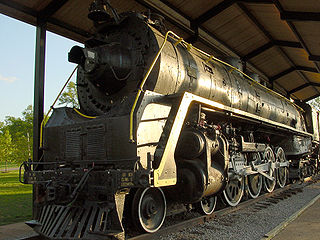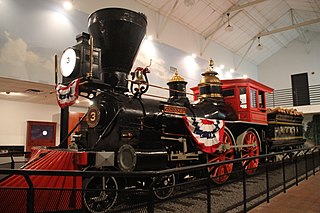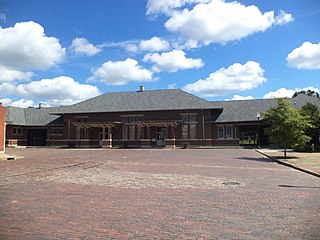
The Western & Atlantic Railroad of the State of Georgia (W&A) is a railroad owned by the State of Georgia and currently leased by CSX, which CSX operates in the Southeastern United States from Atlanta, Georgia, to Chattanooga, Tennessee.

The Great Locomotive Chase was a military raid that occurred April 12, 1862, in northern Georgia during the American Civil War. Volunteers from the Union Army, led by civilian scout James J. Andrews, commandeered a train, The General, and took it northward toward Chattanooga, Tennessee, doing as much damage as possible to the vital Western and Atlantic Railroad (W&A) line from Atlanta to Chattanooga as they went. They were pursued by Confederate forces at first on foot, and later on a succession of locomotives, including The Texas, for 87 miles (140 km).

The Nashville, Chattanooga and St. Louis Railway was a railway company that operated in the U.S. states of Kentucky, Tennessee, Alabama, and Georgia. It began as the Nashville and Chattanooga Railroad, chartered in Nashville on December 11, 1845, built to 5 ft gauge and was the first railway to operate in the state of Tennessee. By the turn of the twentieth century, the NC&StL grew into one of the most important railway systems in the southern United States.

The Louisville and Nashville Railroad, commonly called the L&N, was a Class I railroad that operated freight and passenger services in the southeast United States.

The Northwest Railway Museum (NRM) is a railroad museum in Snoqualmie, King County, Washington. It incorporates a heritage railway, historic depot, exhibit hall, library, and collection care center, and serves more than 130,000 visitors per year.

The Tennessee Valley Railroad Museum is a railroad museum and heritage railroad in Chattanooga, Tennessee.

Western & Atlantic Railroad #3 General is a 4-4-0 "American" type steam locomotive built in 1855 by the Rogers, Ketchum & Grosvenor in Paterson, New Jersey for the Western & Atlantic Railroad, best known as the engine stolen by Union spies in the Great Locomotive Chase, an attempt to cripple the Confederate rail network during the American Civil War. Today, the locomotive is preserved at the Southern Museum of Civil War and Locomotive History in Kennesaw, Georgia, and is listed on the National Register of Historic Places.
A union station is a type of railroad station used by more than one railroad company, line, or service provider, typically found in North America.
The Louisville and Nashville Depot, or Louisville and Nashville Railroad Depot or Louisville and Nashville Passenger Station, Louisville and Nashville Railroad Passenger Depot or variations, may refer to the following former and active train stations previously used by the Louisville and Nashville Railroad. Some of these are listed on the National Register of Historic Places (NRHP).

The Atchison, Topeka and Santa Fe Passenger and Freight Complex is a nationally recognized historic district located in Fort Madison, Iowa, United States. It was listed on the National Register of Historic Places in 1992. At the time of its nomination it contained three resources, all of which are contributing buildings. The buildings were constructed over a 24-year time period, and reflect the styles that were popular when they were built. The facility currently houses a local history museum, and after renovations a portion of it was converted back to a passenger train depot for Amtrak, which opened on December 15, 2021.

The Historic Railpark and Train Museum, formerly the Louisville and Nashville Railroad Station in Bowling Green, Kentucky, is located in the historic railroad station. The building was placed on the National Register of Historic Places on December 18, 1979. Opened in 1925, the standing depot is the third Louisville & Nashville Railroad depot that served Bowling Green.

The St. Louis County Depot is a historic railroad station in Duluth, Minnesota, United States. It was built as a union station in 1892, serving seven railroads at its peak. Rail service ceased in 1969 and the building was threatened with demolition until it reopened in 1973 as St. Louis County Heritage & Arts Center . Train service also resumed from 1974 to 1985, by Amtrak.

The Union Station in Owensboro, Kentucky, is a historic railroad station, built in 1905. Built mostly for the Louisville and Nashville Railroad, the station is made of limestone and slate, and currently is home to several businesses.

The Berea Union Depot is a train station in Berea, Ohio, United States, which was built in 1876. As the railroad facilities through town grew, there was a demand in the early 1870s by developers and townspeople for a new passenger and freight station. When it was dedicated on May 3, 1876, The Plain Dealer called it "the finest facility outside the big cities." As a union station, it served the Lake Shore and Michigan Southern Railway and the Cleveland, Cincinnati, Chicago and St. Louis Railway, both of which became part of New York Central Railroad. It ceased to serve as a railway depot in 1954. In 1980, the building was restored as a restaurant and gathering place.

The Cotton Belt Depot Museum is a museum located in the historic railroad depot in Tyler, Texas, United States.

Albany Railroad Depot Historic District is located at the 100 block of West Roosevelt Avenue in Albany, Georgia, United States, and is governed by the Thronateeska Heritage Center, a 501(c)3 not-for-profit organization incorporated in 1974 for the purpose of historic preservation and science education in Southwest Georgia. The Heritage Plaza includes the Tift Warehouse, the Union Station depot, the Railway Express Agency building and Albany's last remaining brick street and is listed in the National Register of Historic Places (NRHP).

The Western and Atlantic Depot is a historic Western and Atlantic Railroad train depot in Dalton, Georgia. It was built in 1852 in the Greek Revival style. The building is the oldest surviving commercial structure in Dalton and is a "fine example" of depot architecture in Georgia in the mid-1800s. It served as both a freight and passenger station.

The Albertville Depot, also known as L&N Railroad Depot, is a historic train depot in Albertville, Alabama. It was built by the Nashville, Chattanooga and St. Louis Railway in 1892, one year after the town was incorporated. The building measures 112 by 40 feet, and is divided into three rooms: two offices and one larger warehouse space.
Chattanooga Union Station, more commonly known as the Union Depot in Chattanooga, constructed between 1857 and 1859, served as a train car shed in Chattanooga, Tennessee. Located at Broad and Ninth Streets, the station was one of two major railroad terminals in the city, the other being the Southern Railway's Terminal Station.
The Marietta depot is a former freight and passenger stop in Marietta, Georgia. It was originally built in 1864 for the Western and Atlantic Railroad, a railroad between Chattanooga, Tennessee and Atlanta, Georgia. That railroad was absorbed by the Nashville, Chattanooga and St. Louis Railway. In turn, the latter railroad was merged into the Louisville and Nashville Railroad in 1957.



















